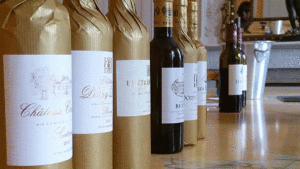
As you may already have noticed, France makes more sparkling wine than just Champagne. Crémant is produced in regions such as Alsace, the Loire Valley, and Burgundy. Let’s take a deep dive into this bubblicious world and explore its similarities and differences to Champagne.
First off, what is crémant?
Before we go any further, let’s clear up what exactly crémant is. Crémant is a sparkling wine made using the same method as Champagne, which is known as the traditional method. You’ll find bottles of crémant from Alsace, the Loire Valley, Burgundy, Bordeaux, Die in the Rhône Valley, Jura, Limoux in Languedoc, and Savoie. Made with an array of grape varieties, these wines tend to be fruit-forward, possessing lively acidity and gentle bubbles. They generally have less flavours linked to yeast, brioche and biscuit as the wines spend less time ageing in their bottles in contact with their lees.
Each of the crémants mentioned above belong to their own appellation, which will stipulate the rules that producers have to follow. For example, in Crémant d’Alsace, aromatic varieties such as Muscat and Gewürztraminer aren’t permitted but Chardonnay is. Meanwhile, due to the rules of its appellation, Crémant de Bourgogne is said to be the closest crémant to a Champagne as it uses very similar principal grape varieties.
A quick overview of the traditional method
The traditional method relies on two alcoholic fermentations with the second one taking place in the bottle to create the beloved bubbles. The first fermentation occurs in a temperature-controlled tank and the resulting base wine from the current year’s harvest will be dry with high acidity – an important characteristic for later steps in the production method.
Next comes blending. Different vineyard plots, grape varieties and reserve wines – previous vintages that have been kept to one side to mature for some time – are mixed with the base wine to improve balance, enhance complexity and style consistency.
Then it is time for the all-important second fermentation. The blended wine is bottled, and a mixture of wine, sugar and yeast is added to it before the bottle is closed with a crown top – like the one you’d find on a beer bottle. The yeast starts a second fermentation which creates carbon dioxide that gets trapped in the wine, adding the famous bubbles.
Once the yeast has finished its important job, the wine is left in the cellar to rest on its lees – the dead yeast cells. For crémant wines, this usually lasts for 9 months and then the sediment formed by the yeast is removed from the bottle and the wine topped up with a mixture of wine and sugar (the sugar in this mixture determines how sweet the finished product will be and is known as the dosage) before the bottle is sealed with a cork. Remember how we said the high acidity of the base wine was important? Well, the dosage brings this acidity into balance.
The wines are then released when ready, probably after another ageing period.
Difference and similarities to Champagne
Similarities
- As stated above, they are both made with the same production method.
- They can both be produced as a white wine or a rosé.
- Both Champagne and crémant come with different dosage levels:
- Brut Nature / Zéro Dosage – no or minimal sugar, making them bone dry with high acidity.
- Extra-Brut – this can be anywhere in the range of 0g/L to 6g/L of residual sugar.
- Brut – containing between 0-12g/L of residual sugar, these feel dry and balanced.
- Extra-Sec – despite the English translation of this label term (extra dry), this is not the driest wine produced with 12-17g/L of residual sugar.
- Sec – starting to feel sweeter, a wine with this on their label, will have 17-32 g/L of residual sugar.
- Demi-Sec – slightly to noticeably sweeter, it would be lovely with spicy food or dessert.
- Both can be served as an aperitif, with fish and shellfish dishes and cheese, although this is less true of crémants from Die and Limoux as they are from sunnier climes.
- Champagne and crémant are produced in AOCs (Appellation d’Origine Contrôlée).
Differences
- Crémant can come from multiple regions (Crémant de Bourgogne, Crémant d’Alsace, etc.) whereas Champagne is produced in the Champagne region. N.B. To be clear, when making a crémant from a certain region, all the grapes will come from the region written on the label.
- The grapes are different:
- Champagne uses 7 varieties with the three main ones being Chardonnay, Pinot Noir and Pinot Meunier.
- Crémant d’Alsace can use Pinot Blanc, Auxerrois, Chardonnay, Riesling, and Pinot Gris, as well as Pinot Noir if a rosé crémant is being produced. Light and floral, these then to have high acidity and delicate bubbles.
- Crémant de Bourgogne’s rules allow Chardonnay, Pinot Noir, Pinot Blanc, Aligoté, and Gamay, creating a structured and elegant wine.
- Crémant de Bordeaux is a fruity blend of the region’s white grapes of Sauvignon Blanc and Sémillon with added Cabernet Franc and/or Merlot for rosés.
- Crémant de Loire’s star is Chenin Blanc, which adds structure and honey notes, supported by Chardonnay, Cabernet, Grolleau and Pineau d’Aunis.
- Crémant de Limoux, created under a Mediterranean sun, making it rich and ripe, are made from Chardonnay, Chenin Blanc, Mauzac, and Pinot Noir.
- Crémant de Jura reflects the region, being crafted from a blend of Chardonnay, Pinot Noir, Poulsard, Trousseau, and Savagnin. They are often complex and nutty with a hint of oxidation and could be paired with fondue or raclette.
- Crémant de Die are fresh and floralwith aromas such as white peach, honeysuckle and citrus fruits, produced from Clairette, Muscat Blanc à Petits Grains and Aligoté.
- Crémant de Savoie reflects its origins with notes from alpine flowers, pear and apple along with being fresh and crisp. The grapes used tend to be Jacquère, Altesse, Chardonnay, and sometimes Mondeuse.
- The minimum requirement for lee ageing for a crémant is nine months, while this is 12 months for a Champagne (both non-vintage and vintage).
- When looking for a wine pairing for Mediterranean dishes, you can turn towards Crémant de Die and Crémant de Limoux. If the dish is tomato based or full of vegetables, a rosé Champagne would be better than a white one.
Some producers to keep an eye on
iDealwine is an Aladin’s cave, bringing together the greatest wine producers. When it comes to crémant a few names spring to mind such as Albert Mann, Kreydenweiss and Valentin Zusslin in Alsace, Arnaud Lambert in the Loire Valley, Domaine Tissot and Fumey-Chatelain in Jura, and Jean-François Quénard in Savoie.



